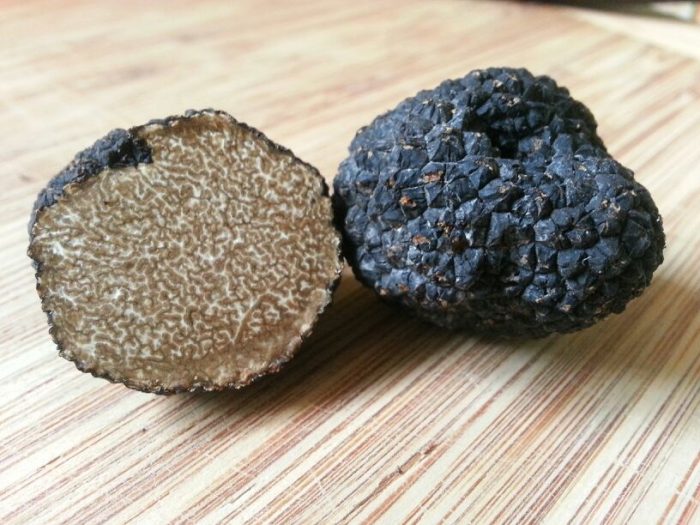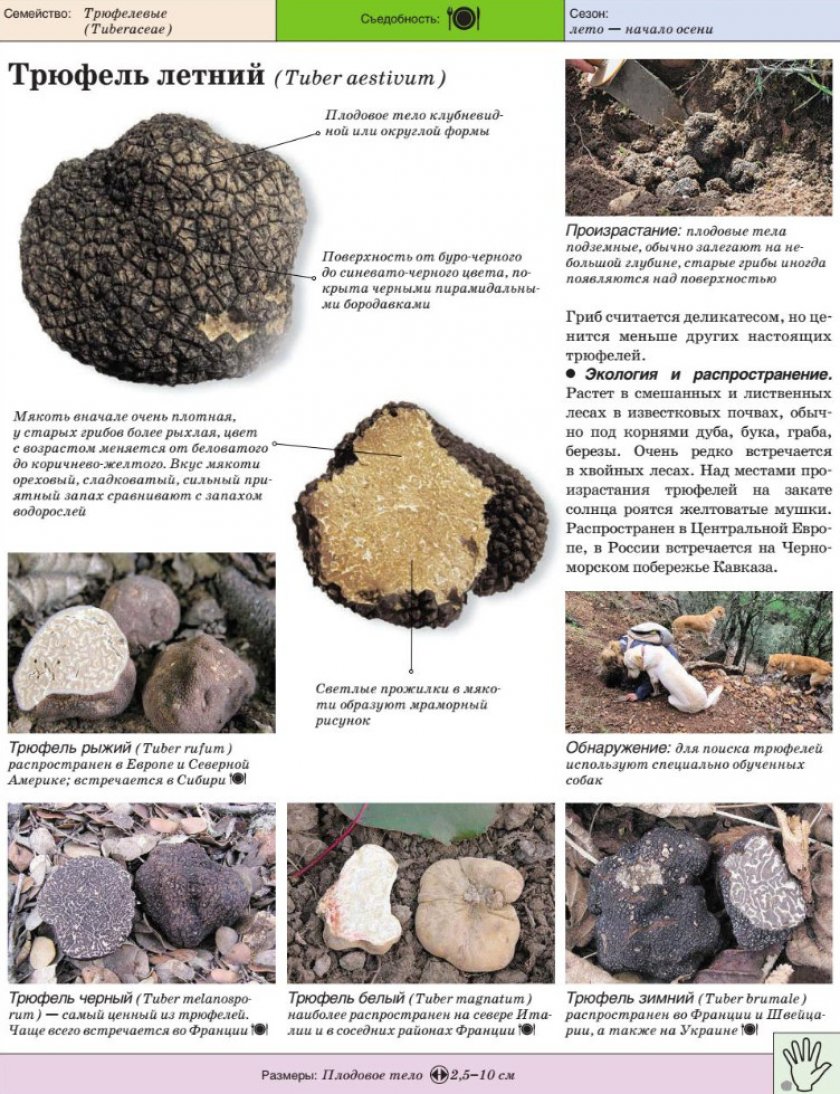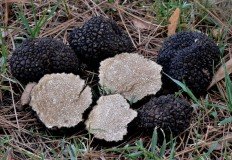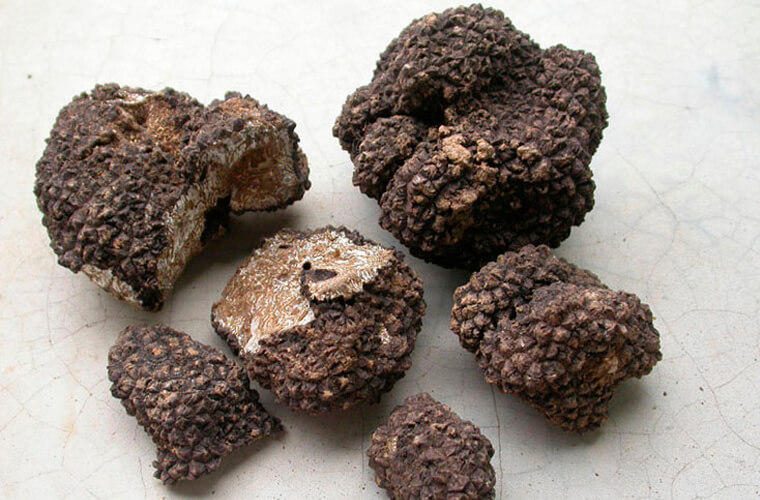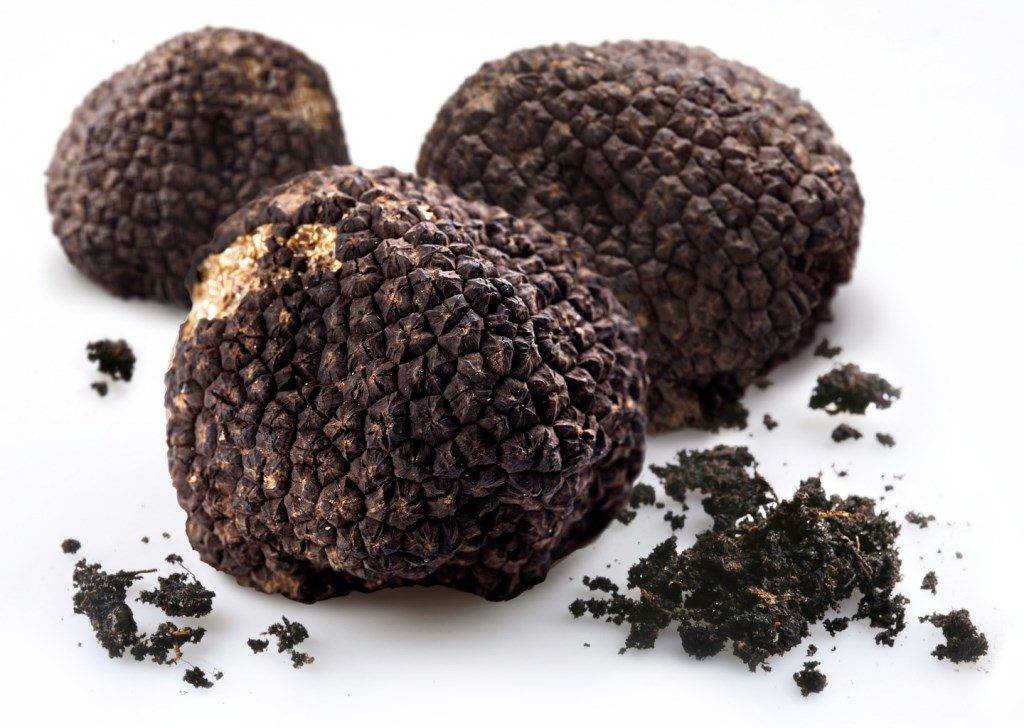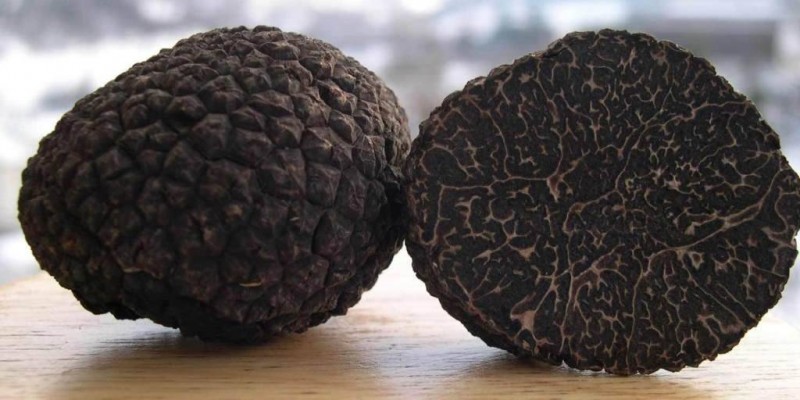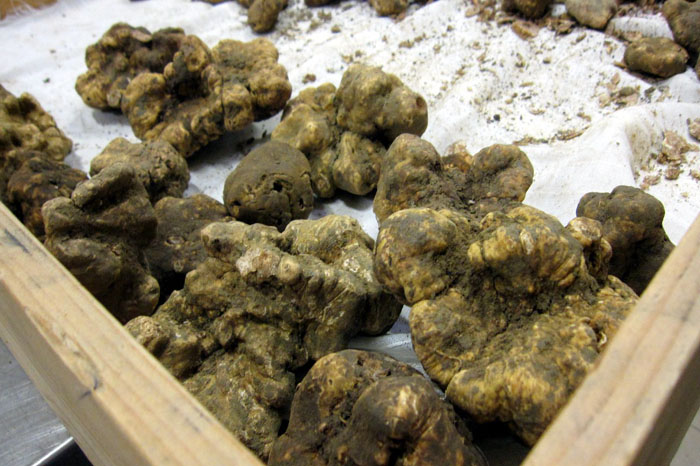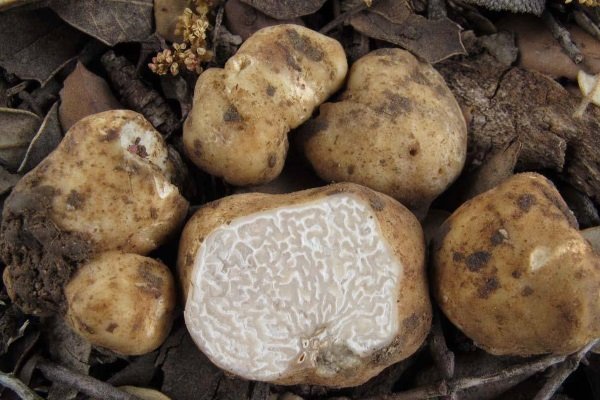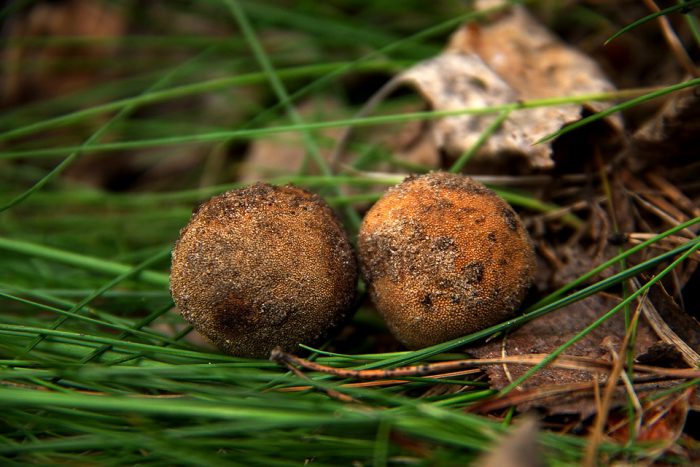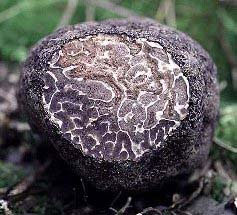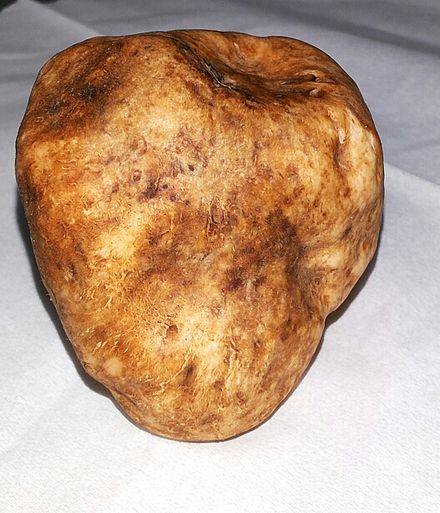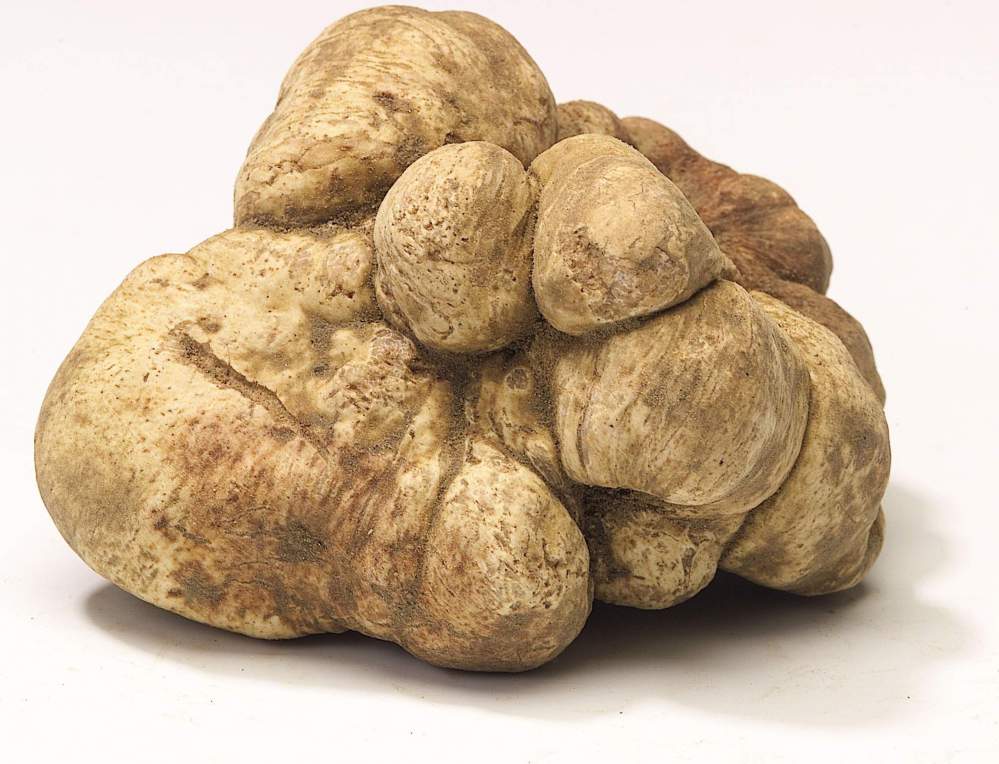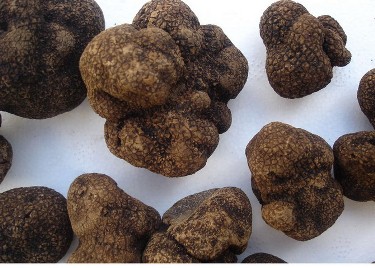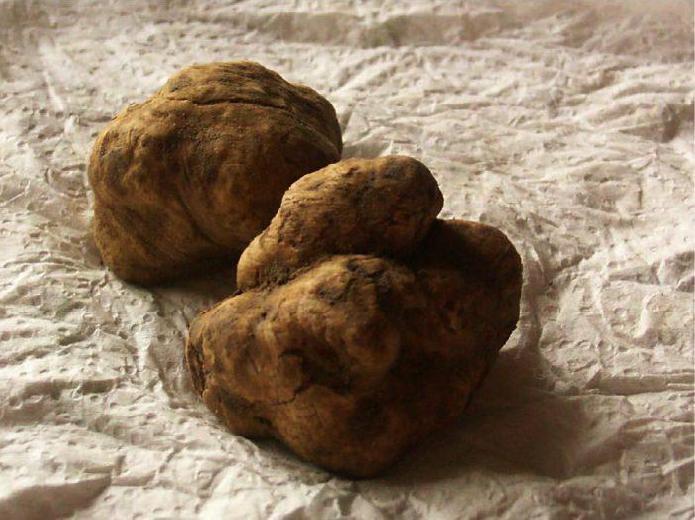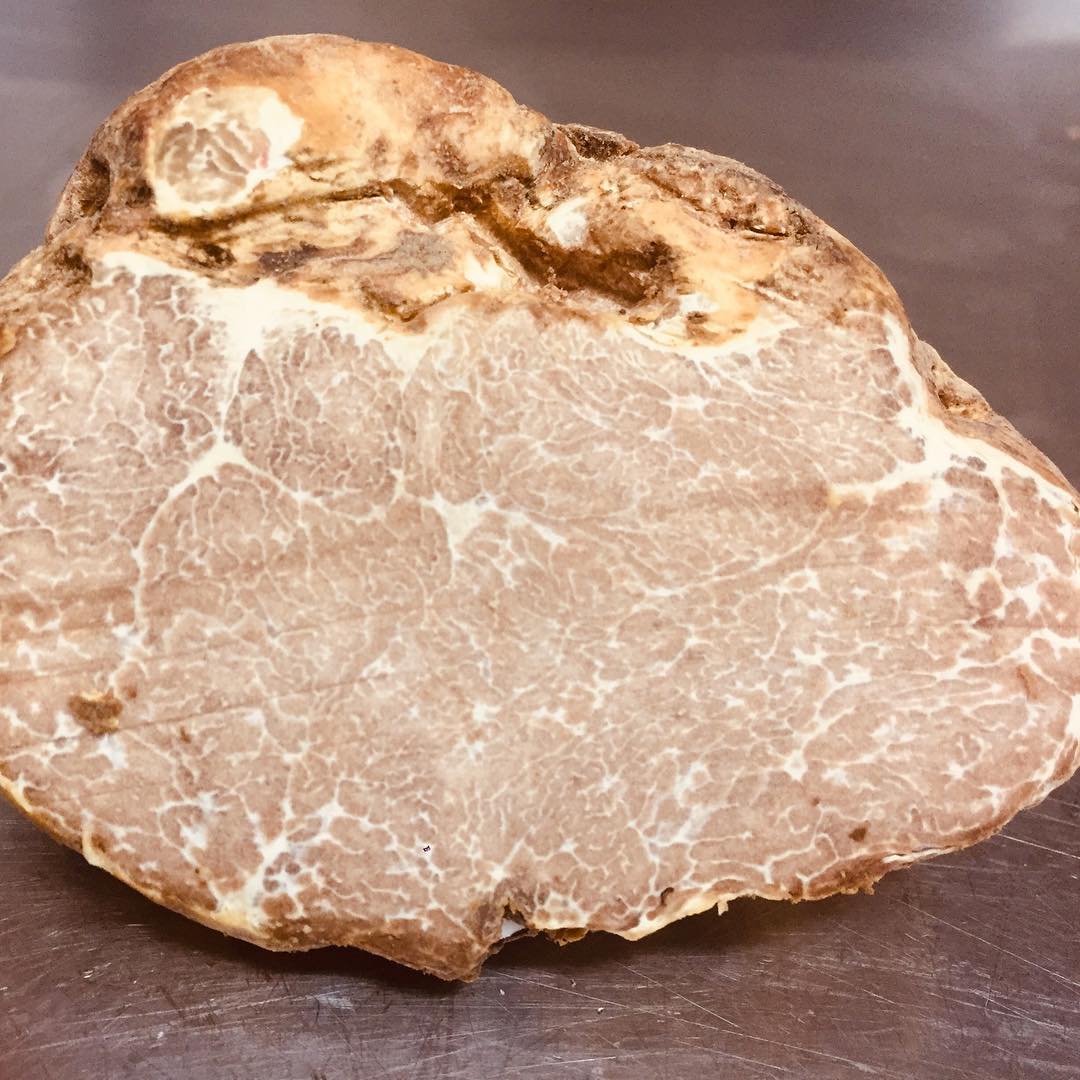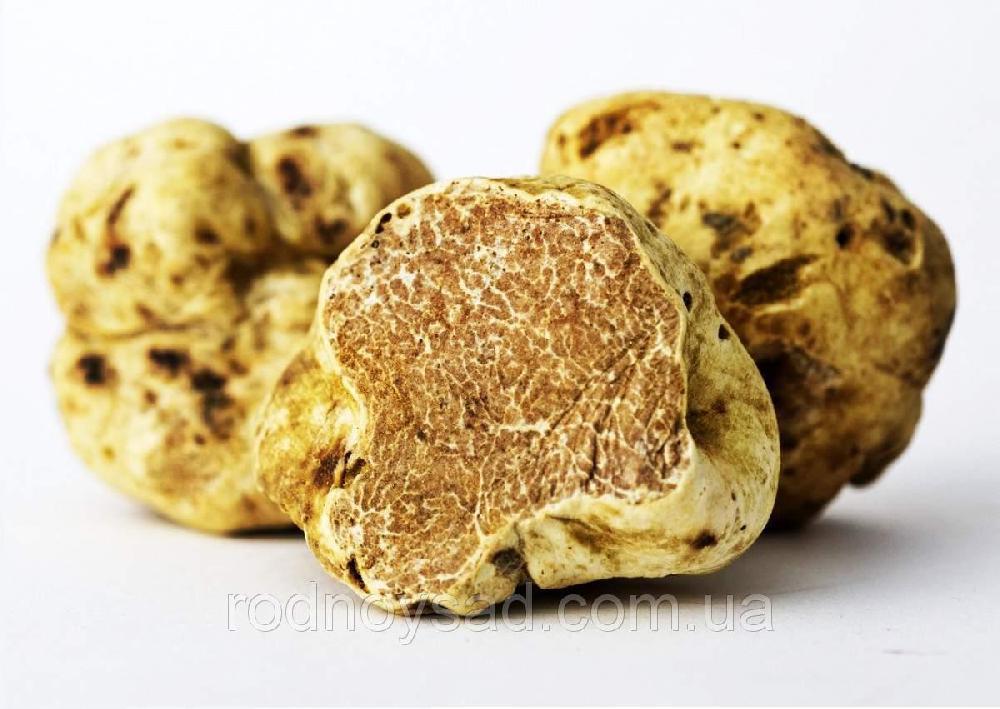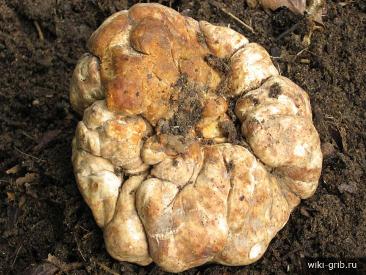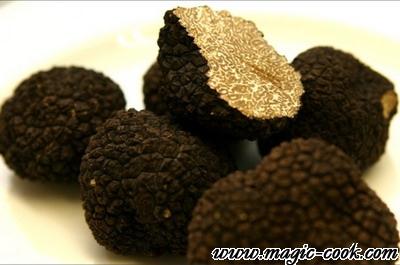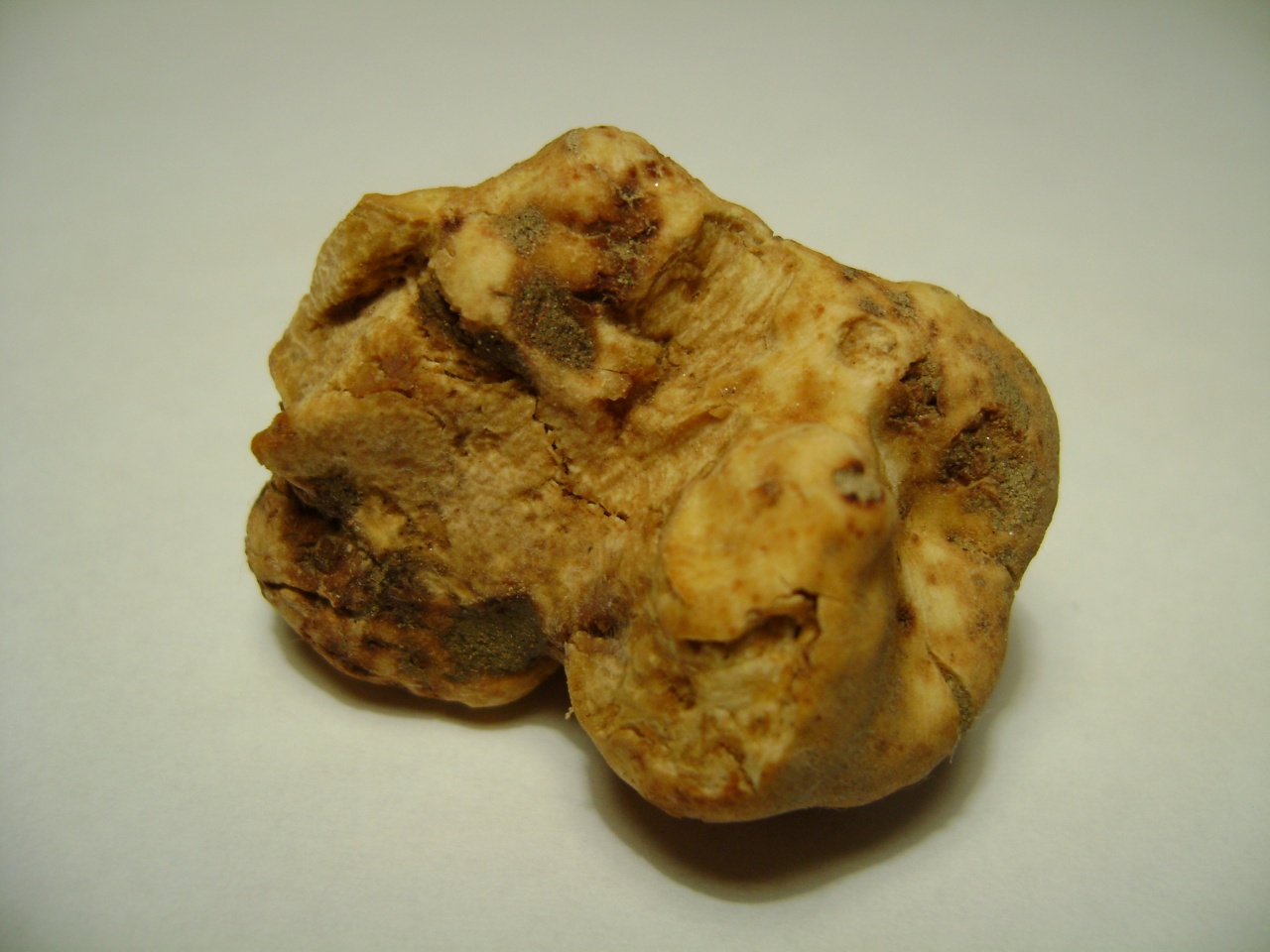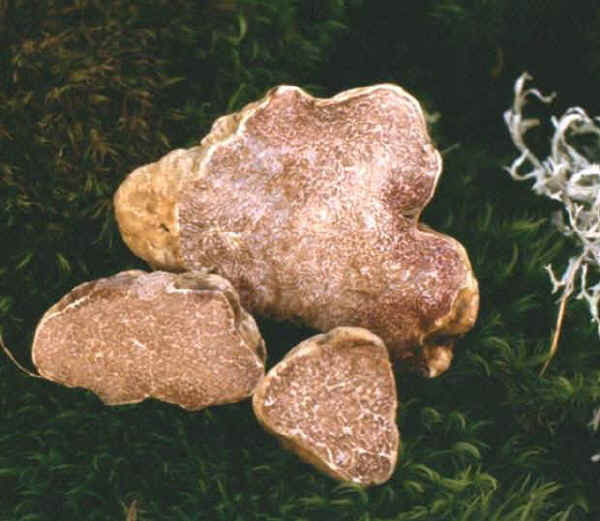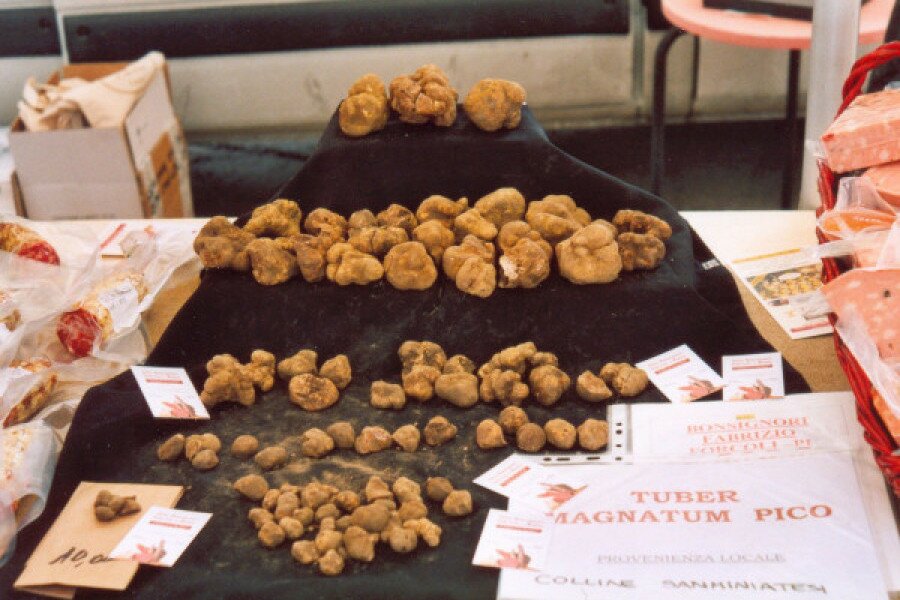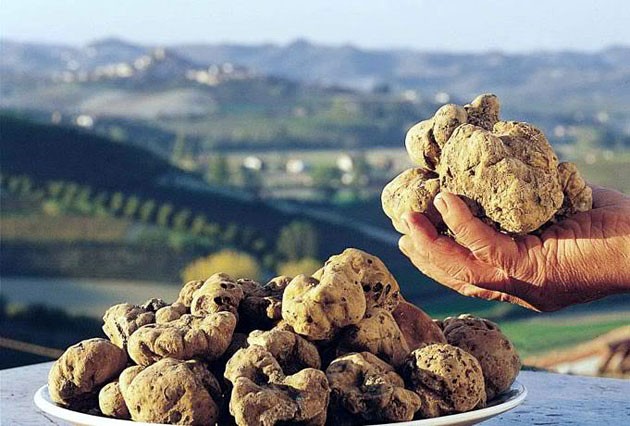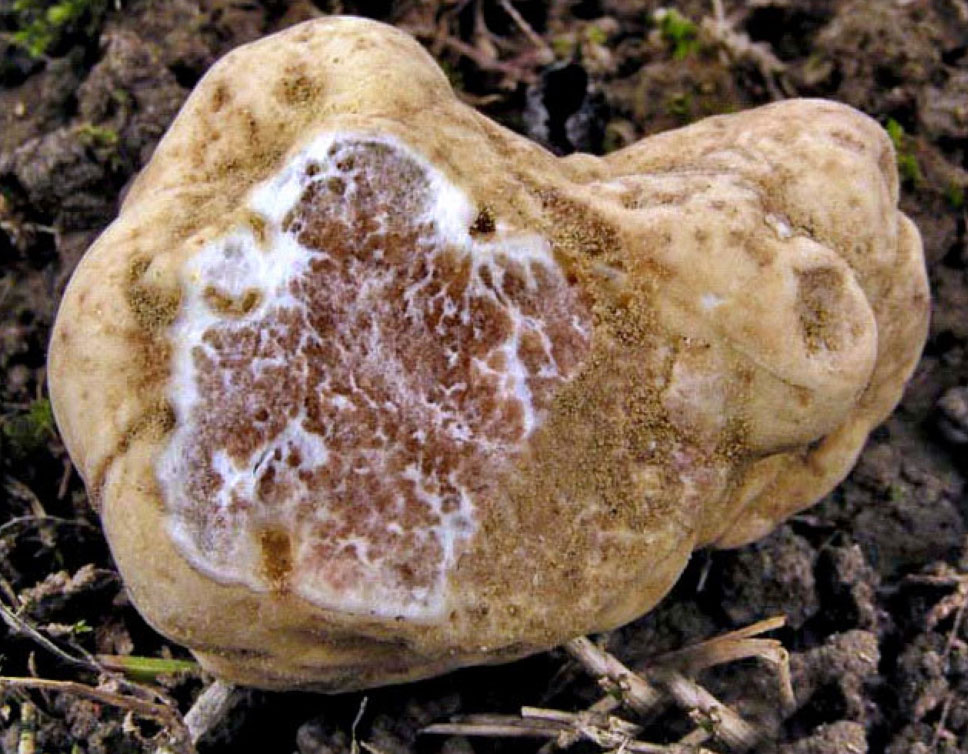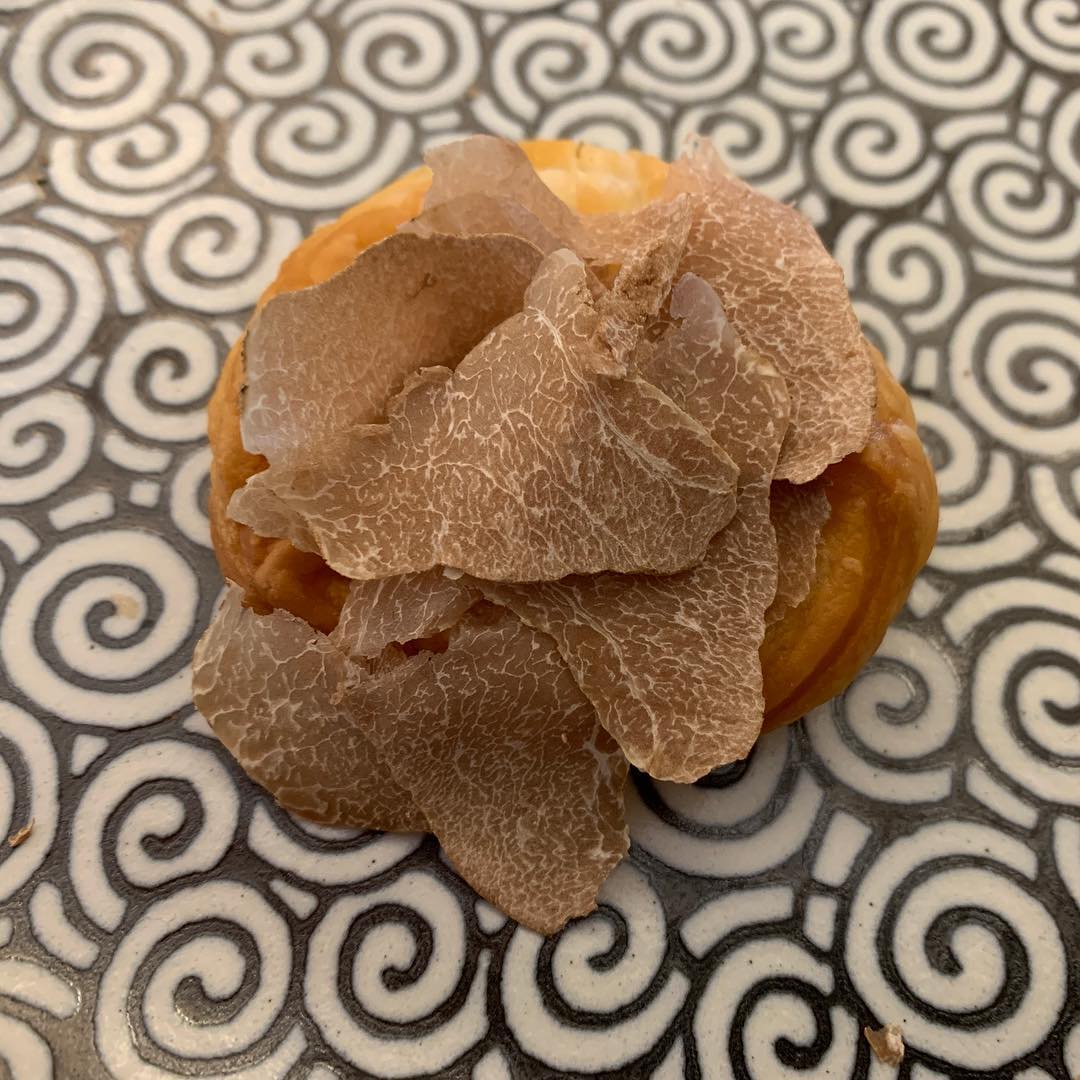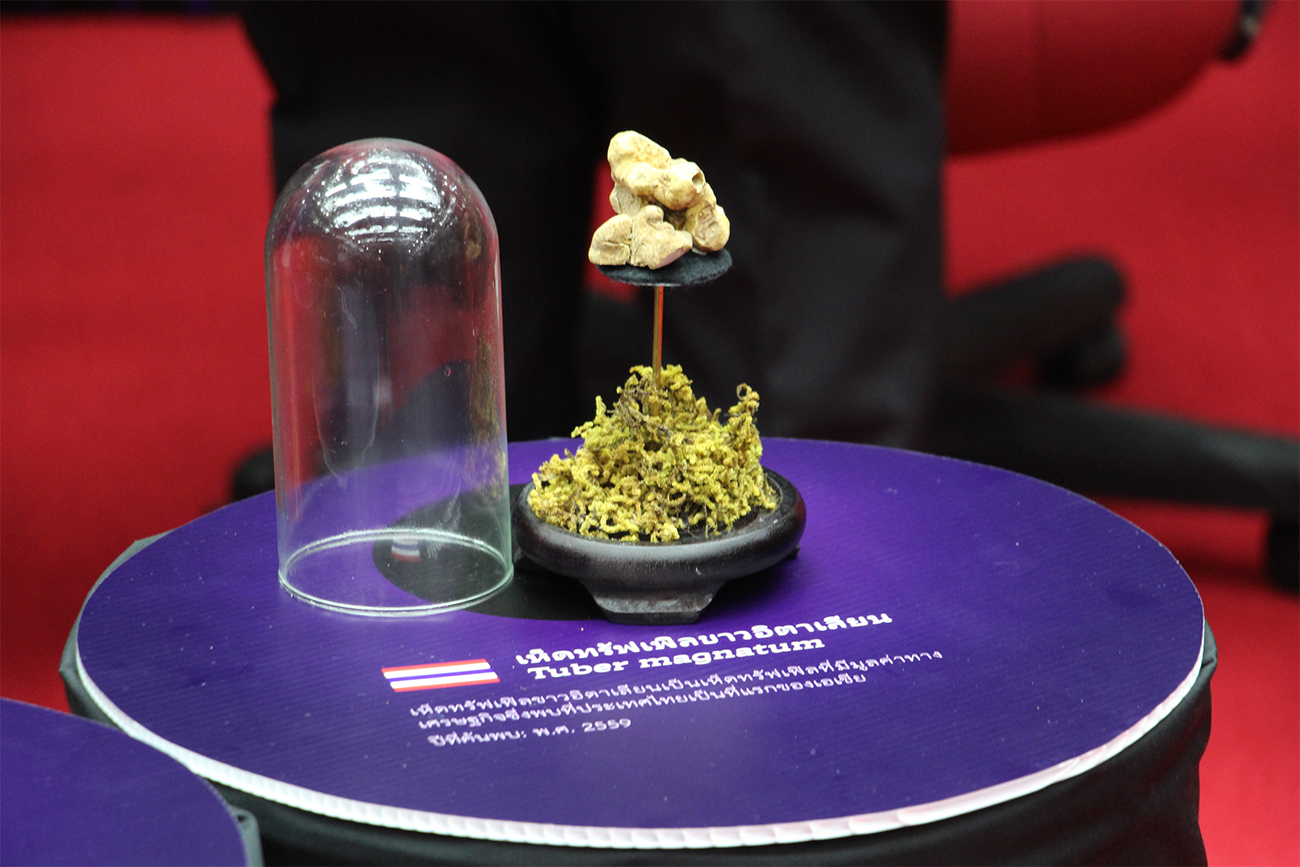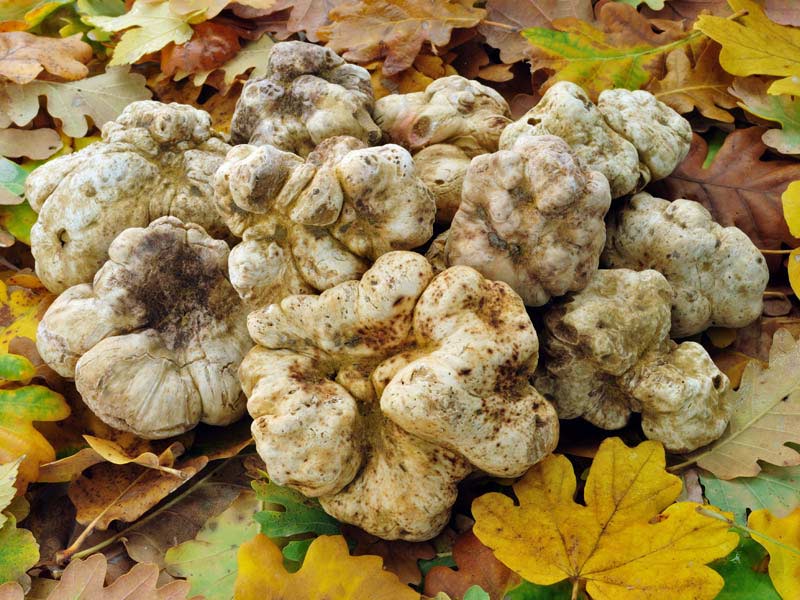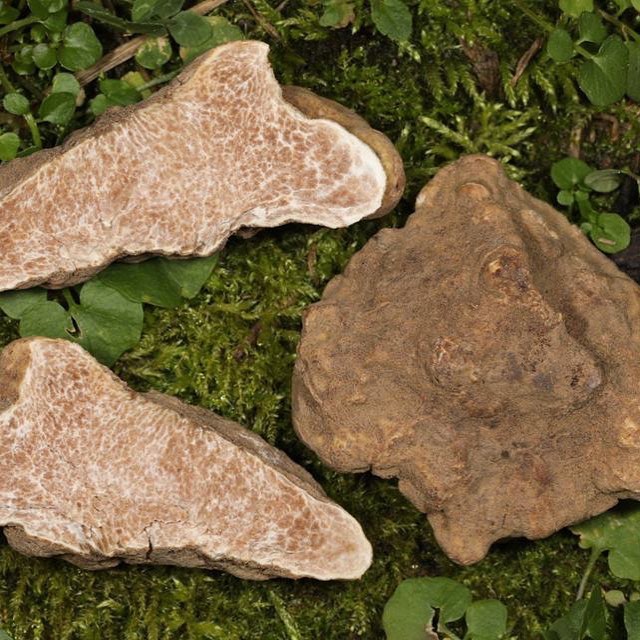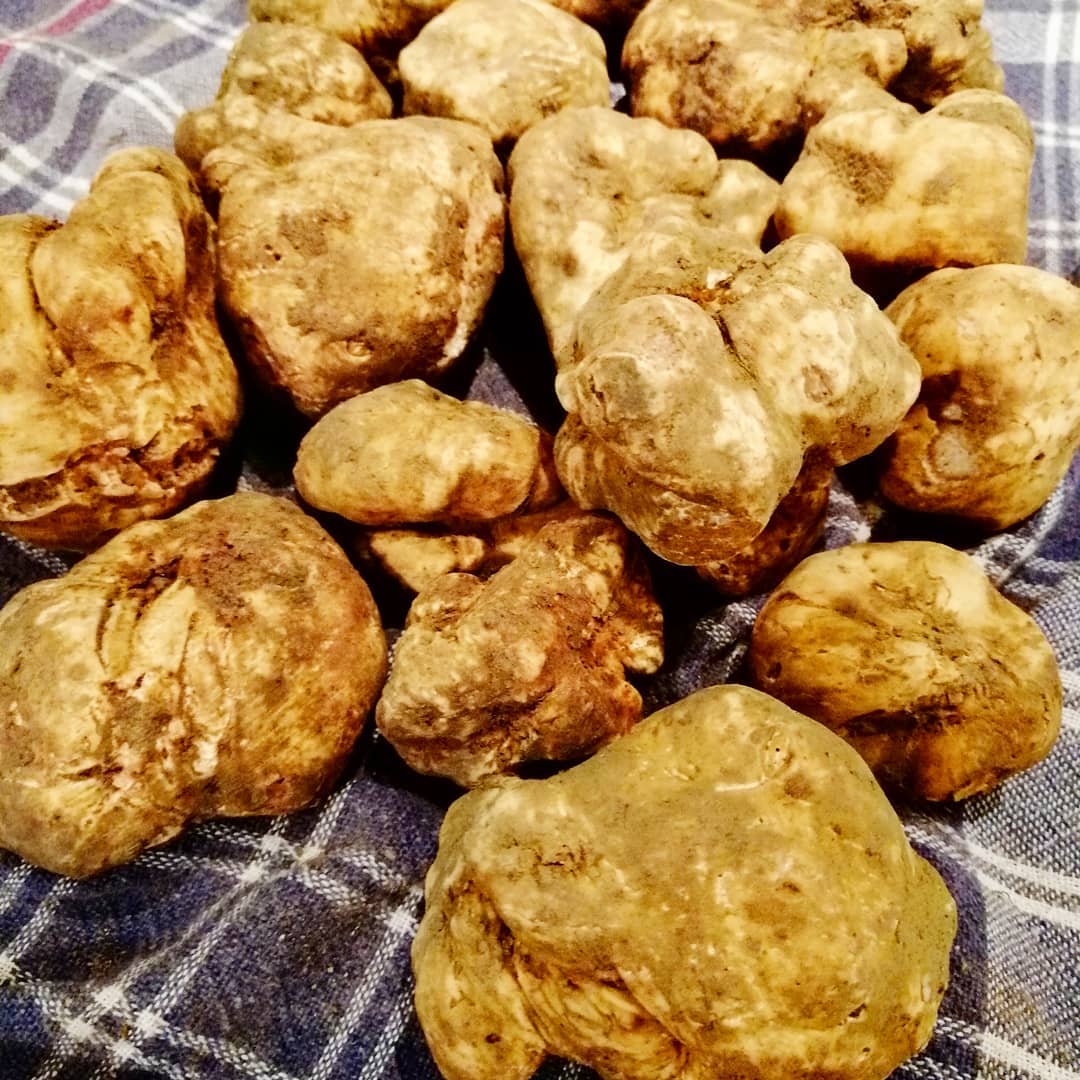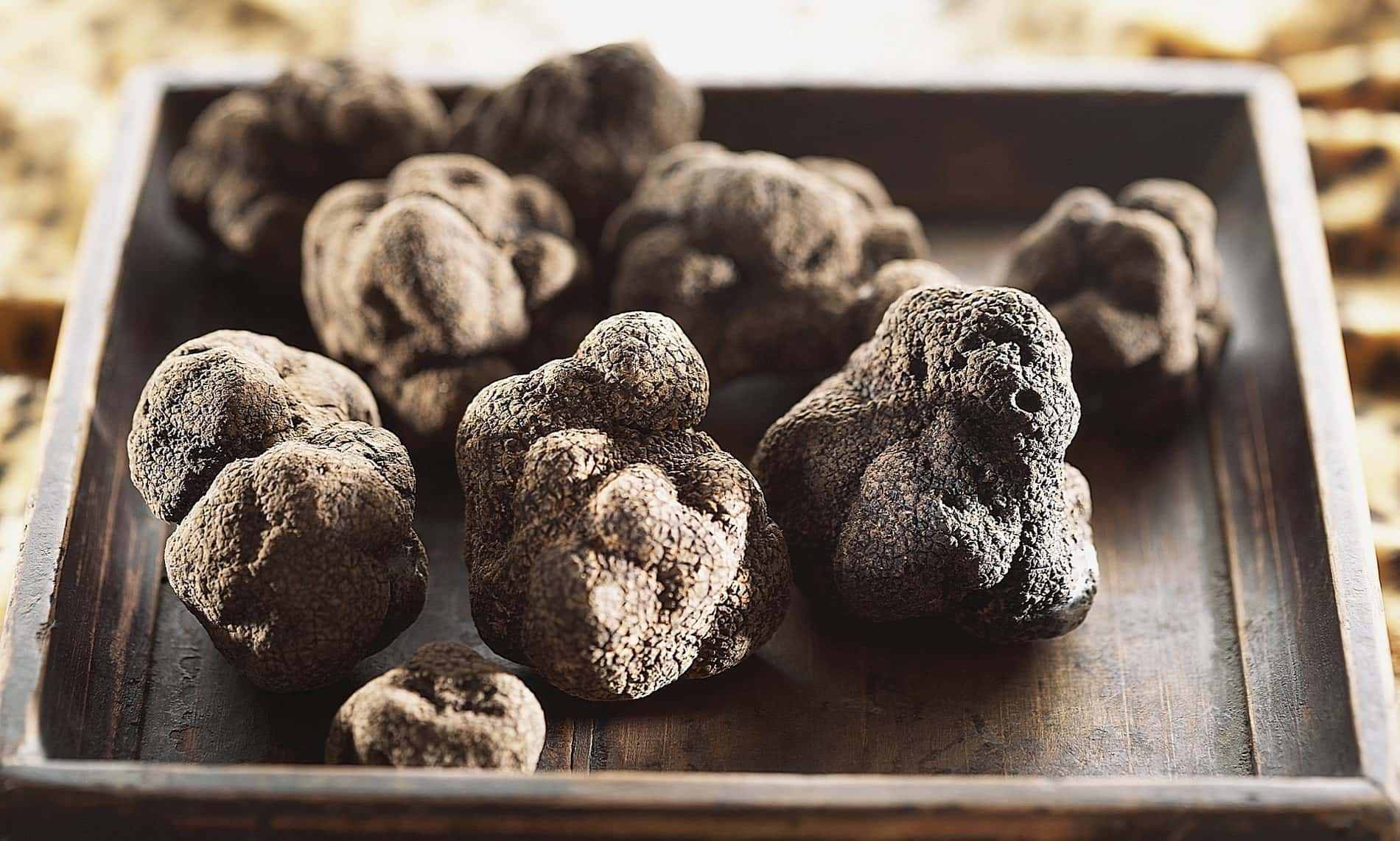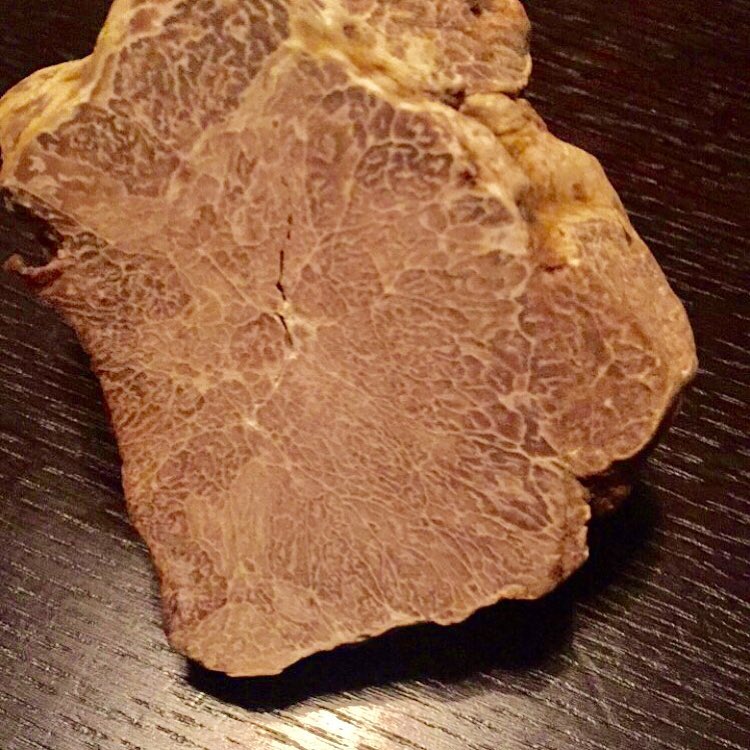Literature
- Mushrooms: Handbook / Per. with ital. F. Dvin. - M.: Astrel, AST, 2001 .-- 384 p. - ISBN 5-17-009961-4 .. - S. 280-281.
- Zheleznov N.I. On the distribution of white truffle in Russia // Bulletin of the Society of Gardeners. - 1883.
- Plant life. Encyclopedia in 6 volumes. T. 2: Mushrooms / Ch. ed. A. A. Fedorov. - M.: Education, 1976 .-- 479 p.
- - S. 30-33.
- Lesso T. Mushrooms: Key / Per. from English L. V. Garibova, S. N. Lekomtseva. - M.: Astrel, AST, 2003 .-- 304 p. - ISBN 5-17-020333-0 .. - S. 258-259.
- Udu J. Mushrooms: Encyclopedia = Le grand livre des Champignons / Per. with fr. - M.: Astrel, AST, 2003 .-- 191 p. - ISBN 5-271-05827-1 .. - S. 170-171.
Varieties
White truffle has an exquisite taste and aroma. In the process of growth, it forms a kind of symbiosis (mycorrhiza) with coniferous or deciduous trees.
There are several varieties of white truffles:
- Piedmont (Tuber magnatum);
- March (Tuber borchii, Tuber albidum);
- Duronsky (Tuber excavatum);
- Variegated (Tuber maculatum);
- Moroccan (Tuber oligospermum);
- Oegon spring (Tubergibbosum).
Truffle White Piedmont (Italian): This species grows in southern Europe. Fruiting from early October to late November. If the weather permits, until January it is found under deciduous or coniferous trees. Its size reaches a volume of 12-15 cm with a weight of 20 g to 1 kg 125 g. The aroma is strong, characteristic (the smell of cheese with garlic). The white Piedmontese truffle is considered the most valuable of all known types. It does not grow in the Moscow region.
Truffle White March: This type is considered European. Symbiotic relationships are formed with deciduous trees, in rare cases with conifers. It is small in size, up to 7 cm in diameter, and weighs from 25 g to 260 g. The taste and smell are subtle. Not particularly valuable in cooking. Known in Crimea. The color changes with the age of the fungus. Young specimens are whitish, then beige and red-brownish at the end. Favorable time for collection is the end of February and March. By the way. With age, the pleasant smell of the truffle is modified and becomes repulsive.
Duronsky white truffle: grows everywhere in Russia and Europe. It thrives on deciduous or coniferous species from September to December. Its size is up to 4 cm, weight is up to 70-80 g. The aroma is interesting, sweetish-spicy, the pulp is dense. In Europe, it is collected independently, but not very often.
There are several types of truffles
White variegated truffle: grows both in Europe and in Russia in conifers (including those with fir) or deciduous forests. Mass collection takes place from June to early September. The sizes are small, up to 1-2 cm and very rarely up to 7 cm. The usual weight of apothecia is 5-20 g and rarely up to 200. The aroma is refined, pleasant. On the basis of the pulp of representatives of this species, they make a delicious, strong-smelling oil for flavoring dishes.
White Moroccan truffle: found in North America, in oak, pine and cedar groves. Mass collection takes place in a short period of time (May-June). Not of interest to the restaurant business. This variety is characterized by a pleasant sweetish nutty aroma. Small size - 2.5-5.5 cm, weight - up to 130 g.
Oregon spring truffle: rarely found in North America (in the northwest), in Canada. It does not grow on the territory of Russia. Fruiting from March to May, in rare cases - to June. It looks neat, has a size of 1.5-5 cm. Weight - from 4 to 200 g. It has a pleasant aroma with a slight hint of spices. The smaller the mushroom, the more expensive it is. It is massively harvested and used in cooking.
Irina Selyutina (Biologist):
On the territory of the Russian Federation, a widespread type of truffle White truffle (Choiromyces meandriformis), which has the names of synonyms - Polish truffle, Troitsky truffle. Despite the Russian-language name "truffle", this species does not belong to the genus Tuber, like real truffles, but to the genus Choiromyces from the same Truffle family (Tuberaceae). This species does not have the same value as real truffles. It grows in several types of forests - coniferous and deciduous.In coniferous forests, it can be found among young pines, and in deciduous forests, it can be found next to birches, aspens, or in hazel trees. The fruit body is located in sandy or clay soil at a depth of no more than 8-10 cm, and sometimes a kind of tubercle without vegetation forms on the soil surface. Has a strong odor. It does not occur annually.
This species belongs to the 4 taste category. It is noted that this type of mushroom is characterized by a meat rather than a mushroom taste.
In the Kostroma region, this species is known as "cow bread".
Truffle mycelium of any kind usually gives rise to 3-7 fruiting bodies, which are arranged in a circle and form a "nest". These places among the collectors were called "truffle".
It takes 3-4 months for a truffle to fully develop.
What does a Piedmont truffle look like?
Fruit bodies are irregularly shaped underground tubers. Their size ranges from 2 to 12 cm, and their weight ranges from 30 to 300 g. In Piedmont, you can find specimens weighing more than 1 kg, but such a find is rare.
The uneven surface of the Piedmont mushroom feels velvety to the touch
Skin color can be light ocher or brownish. The coating does not separate from the pulp.
Spores are oval, mesh. The spore powder is yellow-brown in color.
The pulp has a white or yellowish-gray tint, there are specimens that are reddish inside. In the section, you can see a marble pattern of white or creamy brown. The pulp is dense in consistency.
Important! The taste of mushrooms from Piedmont is considered aristocratic, the smell vaguely resembles the aroma of cheese with garlic additive
Growing at home
Difficulties in finding truffles forced experts to raise the issue of their artificial cultivation. For several centuries, all attempts were unsuccessful, but at the beginning of the 19th century it was successfully cultivated. However, only “black” species grow in an unnatural environment, “white” cultivation truffles are not served.
The main condition is a favorable climate. It should be moderate, warm, without sudden changes in temperature. Regions with hot summers and frosty winters are not suitable for this purpose. Seed material is best bought in a specialized store, but they are not cheap. Usually spores are grafted onto the roots of hazel or oak seedlings.
You can try growing mycorrhiza yourself. Beech or oak sawdust is infected with mycelium and placed in a warm, sterile place until mycorrhiza forms, but this will not happen until a year.
They select a place for planting trees - protected from the wind, direct sunlight, other shrubs, trees, flowers should not grow on its territory. Especially spruce, chestnuts and poplars do not tolerate truffles next to them. The place is protected from the invasion of animals. Truffle loves alkaline soil, if it is acidic, then add lime. And also it should be rich in humus, calcium and saturated with air.
Saplings are planted in the spring. The soil is not pre-fertilized so that the mycelium does not die. It is cleared of weeds, stones and dug holes 75 cm deep, watered. Then the seedlings are planted, covered with soil and watered again. At a distance of 40 cm from each seedling, the ground is mulched with last year's oak leaves. The temperature should be in the region of +20 ° C ... + 22 ° C.
It is recommended to fertilize with potash and nitrogen fertilizers. They are added not to the place where the mushrooms are planted, but to the ground near the roots of the tree where they grow. For the winter, they must be mulched to protect them from frost. In the spring they are fed with mineral fertilizers rich in boron, copper, zinc, calcium and iron.
The timing of harvesting depends on the type of mushroom planted. They hide at a depth of 20 cm from the surface. If the mushrooms rot or lose their nutritional value, then they may be located close to the surface. In this case, it is recommended to sprinkle the surface with clean dry sand. The truffles are dug out with a small spatula.Mushrooms grow not only near the roots of trees, but also are located between them.
Growing a truffle in a greenhouse or basement is expensive. To create optimal conditions, a system of air humidification, heating, ventilation is installed, special soil and means for additional disinfection are purchased. These costs will pay off if truffle cultivation becomes your business.

How to find truffles
To find a truffle in the forest, you need to have special knowledge. They are found near the roots of trees: they are often found near oak trees. Try not to look for fruits in the clear cut areas. Based on practice, such areas are not distinguished by a large number of mushrooms. It is desirable that there be black soil with high humidity. Before starting your search, consider the following:
- Consider the fruits in advance, live or in photographs.
- Prepare to search for animals: Specially trained pigs or dogs will do.
To make the "quiet hunt" successful, be guided by some features of the area. The rules for mushroom pickers are as follows:
The "truffle" area, where the delicacy is located, is distinguished by stunted vegetation, gray-ash soil.
Fungi rarely come to the surface of the soil (sometimes this happens due to strong winds or heavy rains), so look for them in the ground at a depth of 10-15 cm.
Pay attention to the bumps, they should be excavated.
Midges often circle over a place with mushrooms: the larvae feed on mushrooms, so the insects lay eggs nearby.
Growth features
A favorable place for the development of truffles is a large number of tree roots and soil with loose soil with a lot of sand and lime. Experienced mushroom pickers say that if they find one specimen, then you need to continue looking for several more nearby. Typically, you can find about 5 pieces. Truffle often develops in families, rarely singly.
Searching for truffles in the forest
People have been collecting unusual mushrooms for many years.
It is important to consider that there is a false and real mushroom. To return home with the desired prey, it is important to follow a special technology:
- Go to the forest where there are beeches, birches, oaks, hazel.
- Look for fruits near trees with large roots.
- If the search is carried out with the help of pigs, then they should be muzzled, because animals love to feast on mushrooms.
- Keep in mind the appearance of the plant: its surface is rough, the flesh is firm. The fruits resemble black or white potato tubers.
Truffle hunting animals
Mushrooms have a very strong odor that animals can easily pick up even at a distance. For this reason, experienced mushroom pickers prefer to keep specially trained dogs or pigs. The latter are able to smell at a distance of 25 meters. After the aroma is determined, the pig will actively dig up the delicacy. If there is no muzzle, then it is necessary to ensure that the pig does not eat what it finds.
As for dogs, they are indifferent to eating treats, so it is not necessary to wear a muzzle before searching. Before using these four-legged "detectives", it will take a long time to learn the rules of finding mushrooms. The dog needs to be trained to smell. If you are thinking of buying a trained dog, then keep in mind that it costs more than 5000 euros.
Growing methods
The cost of this mushroom is over 1000 USD per 1 kg. They are trying to grow it at home.
In France, truffle cultivation began in 1806, when oaks were planted, under which the first harvest of a delicious plant appeared. Since then, the French have each increased the cultivation area of this tree species and have sold up to a thousand tons of truffles a year.
China is the leader in the production and cultivation of these mushrooms among countries such as America, Sweden, Spain and Australia. But they are not as fragrant as French ones, their quality is much lower.
Growing at home
The fruit body, the edible part itself, or, as is customary among mycologists, apothecia, is the carrier of spores.Growing mushrooms on your own is not easy. But knowing their cost, it's worth giving it a try. Although this will require a rather big start-up capital and an extremely serious approach, in particular, a theoretical one.
To do this, the sprouts (sprouts that emerged from the seeds) of the oak should be infected with mycelium and wait 14 days. After emergence, place the seedlings in sterile conditions and wait for the mycelium to grow and anchor in the roots of the oak.
After that, the cultivation of seedlings in winter is continued in the nursery.
The nursery must be quarantined. Everything must be sterile to make a real delicacy.
After 12 months, the mycorrhiza will fully develop. And when the seedlings grow up to 20 cm, they can be settled in a permanent place.
NPK fertilizers must be applied. To increase yields, preparations containing copper, zinc, magnesium, iron and boron are used.
Weeds are destroyed with herbicide preparations.
There should be no cracks in the soil between young oak trees; they must be covered with earth and watered. Do not plant near chestnuts, willows or poplars. Delicate elite truffles do not tolerate such a neighborhood. They will gladly grow not under oak trees, but under olive or citrus trees.
Interesting Facts
- This type of truffle owes one of its names to the Italian province of Piedmont, where the White Truffle is found most often and is something of a national treasure, national pride.
- White Truffle challenges oysters as the most potent food aphrodisiac. It is believed to be equally effective in enhancing libido in both men and women.
- The number of truffles has dropped dramatically. From ancient times, records have been preserved that describe the use of truffles in literally tons.
In Italy, it is forbidden to use pigs to search for truffles, as was done previously. Not only can the pig just eat the truffle, but in the process of searching, it damages the soil layer and the root system of the plants. Therefore, now specially trained dogs are used to hunt truffles, which, by the way, are no cheaper than the truffles themselves, since the process of training such a dog is a very long and expensive process.
It is also known by names such as white truffle or Piedmont truffle. The latter name is associated with the Piedmont region in northern Italy, where these mushrooms grow.
Timeline ‹Our cuisine‹ White truffle, Italian (Tuber magnatum)
Posted on 16 Sep 2018 12:54 pm, Last modified 24 Sep 2018 12:50 pm
Order: Pezizales; Family: Truffle (Tuberaceae); Genus: Truffle (Tuber); Species and synonyms: Truffle white, Italian, real, Piedmontese (Tuber magnatum, Rhizopogon magnatus, Choiromyces gangliodes f. Magnatum). The most rare, and therefore the most expensive kind of truffle. Experienced mushroom pickers know the right signs of how to find these underground treasures. For example, dry soil around a tree can serve as a sign - this is the result of the influence of an underground mycelium. A reliable remedy is the delicate smell of mushrooms, it is invisible to humans, but flies feel it and accumulate in places where truffles grow. Truffle hunting is a complex process that requires painstaking preparation. These mushrooms grow one by one, so you have to spend a lot of time for each specimen found. It is very difficult to move the mushroom away from the tree, since their flesh is very delicate and easily damaged. White truffles appear in October, and according to tradition, a truffle fair is held in Piedmont at this time. This delicacy can be bought at the fair in any form: fresh, canned, dried. Locals call truffles “diamond mushrooms” and “white gold”, and this is justified, because their cost is simply fabulous - up to 8 thousand dollars per kilogram. The yield of Italian truffles changes from year to year, it is impossible to predict it. In years of poor yields, the price of these delicacies can rise significantly. In addition, these mushrooms have a very short fruiting season.In Italy, the search for truffles begins in November. The most expensive, naturally, are fresh truffles. Even many restaurants prepare a special menu during the truffle season. Many people try to grow truffles artificially, and the Chinese manage to do it with black truffles. Although “Chinese black truffle” and “poor quality product” are synonymous, they have their own customers due to their low price. But no one has yet managed to grow white truffles artificially. Truffles have a short shelf life, they are not stored in pure form, but in sauces or oil. Therefore, connoisseurs of Italian truffles manage to taste this delicacy exclusively during the hunting season, and then they spoil. Restaurateurs buy up these mushrooms literally in a matter of days. Fruit body: (modified apothecia) underground, in the form of irregular tubers, usually 2-12 cm in size and weighing 30-300 g. Occasionally there are specimens weighing 1 kg or more. The surface is uneven, covered with a thin velvety skin that does not separate from the pulp, light ocher or brownish in color. The pulp is firm, whitish to yellow-gray in color, sometimes with a reddish tint, with a white and creamy brown marble pattern. The taste is pleasant, the smell is spicy, reminiscent of cheese with garlic. Spore powder, yellowish-brown, spores 40 × 35 microns, oval, reticulate Habitat: forms mycorrhiza with oak, willow and poplar, also found under lindens. Grows in deciduous forests with loose calcareous soil at varying depths. Most common in northwestern Italy (Piedmont) and adjacent regions of France, found in Central Italy, Central and Southern France and other areas of southern Europe. Fruiting period: the collection of the white Piedmont truffle officially begins on September 21st and ends on January 31st. These mushrooms are harvested, only with the help of trained dogs, pigs in Italy for collecting truffles are prohibited. Edible: it is not just an edible mushroom, it is a delicacy. In Italian cuisine, these mushrooms are almost always used raw. They are grated on a special grater and added to sauces or used as a seasoning for various dishes, for example, risotto, salads, scrambled eggs, and so on. Also, seafood, veal, grilled meat are cooked with these mushrooms. The most important thing about truffles is their unique aroma, which becomes even stronger when cooked. This white truffle has light notes of pepper, garlic and honey. Italian truffles taste softer and more refined than black French truffles. They contain more gaseous substances that are released when the pulp is pressed. In the Middle Ages, these mushrooms were harvested in hundreds of tons per season, then they were simply boiled in wine and served as a snack. Gourmets around the world agree that the taste of fresh white truffles is incomparable to other products.
False doubles
Among the similar species are:
Tuber gibbosum, native to the northwestern United States of America. The name gibbosum means "humpbacked", which very accurately characterizes the appearance of the underground mushroom. When ripe, thickenings are formed on its surface, resembling irregular petals or humps on large specimens. This species is edible, used similarly to the European representatives of the mushroom kingdom. Truffle aroma adds sophistication to the dish;
This representative of the Truffle family is found in coniferous forests, because forms mycorrhiza with Douglas fir
Choiromyces meandriformis or Troitsky truffle found in Russia. The mushroom is not as valuable as its European counterpart. It grows in deciduous, coniferous and mixed forests at a depth of 7-10 cm. The size of the fruit body: diameter 5-9 cm, weight 200-300 g. There are also larger specimens weighing about 0.5 kg, up to 15 cm in diameter. Fruit body resembles a round-flattened yellowish-brown felt tuber. The pulp is light, similar in appearance to potatoes, streaked with marble veins.The aroma is specific, the taste is mushroom, with a nutty note. The mushroom is classified as edible. You can find it by the bumps in the soil and a specific aroma. Often animals find him, and only then the person starts collecting the delicacy.
Appearance season - from August to November
White truffle description.
The most popular gourmet variety of truffles is considered to be black - they are served in elite restaurants, they have an unusual delicate, meaty taste and an indescribable smell. But, white truffle differs from black, not only in external characteristics, but also in composition and taste. White truffle is also part of the Truffle family.
It is important to note that the appearance of the white truffle is very different from the traditional fruiting bodies, which consist of a cap and a leg. The fruit body of a white truffle is apothecia, which can be completely submerged in the soil or slightly protrude above the surface
In appearance, a truffle is similar to a potato tuber - it has an irregular rounded shape, its surface is smooth.
The young mushroom has a white, smooth surface. In mature mushrooms, it acquires a yellowish tint, becomes wrinkled - covered with winding veins. With age, spots of irregular shape with a reddish tint can appear on the surface of the fungus. The volume of the fruit body is up to 12 cm. White truffle spores are large, spherical, with processes.
Literature
- Mushrooms: Handbook / Per. with ital. F. Dvin. - M.: Astrel, AST, 2001 .-- 384 p. - ISBN 5-17-009961-4 .. - S. 280-281.
- Zheleznov N.I. On the distribution of white truffle in Russia // Bulletin of the Society of Gardeners. - 1883.
- Plant life. Encyclopedia in 6 volumes. T. 2: Mushrooms / Ch. ed. A. A. Fedorov. - M.: Education, 1976 .-- 479 p.
- - S. 30-33.
- Lesso T. Mushrooms: Key / Per. from English L. V. Garibova, S. N. Lekomtseva. - M.: Astrel, AST, 2003 .-- 304 p. - ISBN 5-17-020333-0 .. - S. 258-259.
- Udu J. Mushrooms: Encyclopedia = Le grand livre des Champignons / Per. with fr. - M.: Astrel, AST, 2003 .-- 191 p. - ISBN 5-271-05827-1 .. - S. 170-171.
Types of mushroom truffle
Summer truffle (Tuber aestivum)
The fruit body is underground, tuberous or rounded, 2.5-10 cm in diameter. The surface is brown-black or bluish-black, covered with black warts. The flesh of a young mushroom is dense, becomes friable over time, the color changes from whitish to brown-yellow and gray-brown, light veins form a marble pattern. The taste is nutty, sweetish, the aroma is pleasant and strong.
It is found in mixed and deciduous forests, on calcareous soils, under oak, beech, hornbeam, birch, in Central Europe, in Russia. The fruiting season begins in summer and lasts until early autumn.
Winter truffle (Tuber brumale)
The fruit body is irregularly spherical to almost round, 8-15 cm in diameter. The weight of an adult mushroom is 1-1.5 kg. The surface is covered with warts, 2-3 mm in size. The color of a young mushroom is reddish-purple, turns black with age. The pulp is white at first, then becomes gray or gray-violet with white and yellowish-brown marble veins. Has a strong and pleasant scent reminiscent of musk.
Grows in France, Italy, Switzerland, Ukraine. Ripens from November to February-March.
Italian truffle (Tuber magnatum)
The fruit body is underground, has the shape of irregular tubers measuring 2-12 cm and weighing 30-300 g. The surface is uneven, velvety, light buffy or brownish, the skin does not separate from the pulp. The pulp is firm, whitish or yellow-gray, sometimes reddish, with a white and creamy brown marble pattern. The taste is pleasant, the smell is spicy, similar to cheese with garlic.
Mycorrhizal forming agent with oak, willow and poplar, lindens. Found in deciduous forests in northwestern Italy (Piedmont), France. The collection of the white Piedmont truffle lasts from 21 September to 31 January.
Black truffle, or Perigor (Tuber melanosporum)
The fruit body is underground, tuberous, round or irregular in shape, 3-9 cm in diameter.The surface is reddish-brown, coal-black in old mushrooms, becomes rusty when pressed. The flesh is firm, light, gray or pinkish-brown in color with a white or reddish marbled pattern, in old mushrooms it is dark. It has a strong characteristic aroma and pleasant taste with slight bitterness.
Grows in deciduous forests, on calcareous soil, most often under oak trees. Distributed in France, Italy and Spain. The season runs from November to March.
The most iconic
There are many types of truffles, and below are the most significant or important ones for the Russian mushroom picker.
Truffle Summer or Black Russian Tuber Aestivum
Truffle Summer or Black Russian Tuber Aestivum
The most interesting for the Russian mushroom picker, since this is the only kind of real truffle that grows in our homeland.
Appearance
Fruit bodies up to 10 cm in diameter., Bluish - black or brownish - black shade. Their surface is covered with characteristic brown-black pyramidal warts.
The pulp, in youth, is dense, yellowish-white or slightly grayish, in mature fruit bodies it is brownish-yellow with numerous light veins and looser. The pulp has a very pleasant smell and delicate sweetish - nutty taste.
Where and when Grows
Grows in deciduous and mixed forests, most often on calcareous soils. Forms mycorrhiza with hornbeam, beech and oak, sometimes with birches and pines. Fruiting at a depth of 3 to 15 cm, sometimes even deeper. Old fruiting bodies sometimes protrude above the ground.
Occurs in different regions of Russia from late July to late November. Most often and confidently, this species bears fruit in the forest-steppe zone of the Crimea and on the Black Sea coast of the Caucasus.
Truffle Italian or Piedmont Tuber Magnatum
Truffle Italian or Piedmont Tuber Magnatum
It is also called Real White. One of the most delicious and connoisseurs' favorite truffle, named after the Piedmont region of Northern Italy.
Appearance
Fruit bodies look like tubers of irregular shape, brownish or light ocher, up to 12 cm in diameter and weighing up to 300 grams. There are known cases of finding specimens up to a kilogram in weight. From above, the fruiting bodies are covered with a velvety skin.
The pulp is dense, light, sometimes with a slightly reddish tint and creamy brown marble pattern. The pulp tastes good and smells like garlic cheese.
Where and When It Grows
It grows from early summer to early winter on loose calcareous soil in deciduous forests. Forms mycorrhiza with oak, poplar and willow and linden. Distributed in northern Italy, southern and central Italy and southern Europe.
In Europe, this species is one of the main delicacies. They eat it raw, grated on a special grater or cut into slices, as a component of salads, as a seasoning for sauces and other various dishes.
Distribution and collection
Unfortunately for mushroom pickers, the Italian truffle does not grow on the territory of Russia. Its habitat belongs exclusively to Southern Europe, in particular, most often the white Truffle is found in Italy and France, and occasionally in Spain.
Finding the White Truffle is not easy. Its fruiting body is always located underground, and the depth of occurrence can vary from 5 cm to 20-25 centimeters. There are signs that can help find a truffle. First, over the fruiting body of the truffle, the herbaceous vegetation often dies out, which is due to the substances released by the truffle in the process of life. Secondly, flies often swarm over the place where the truffle grows, which lay their larvae in the fruit bodies.
Truffles are very demanding on temperature, moisture and soil composition. It grows exclusively in deciduous forests, preferring oak forests. The soil should be loose, well-ventilated, calcareous.
In places where white truffles were originally grown, they are harvested during late autumn and winter.

